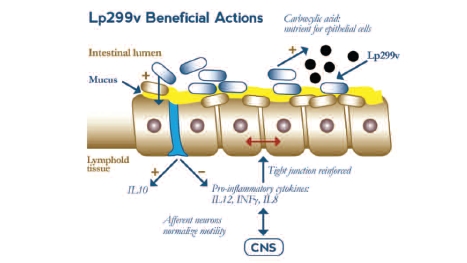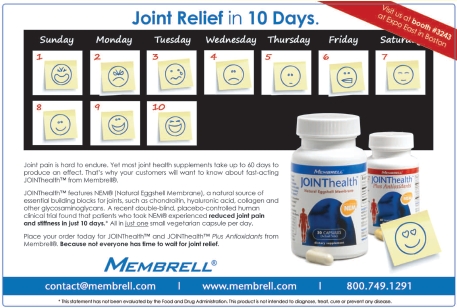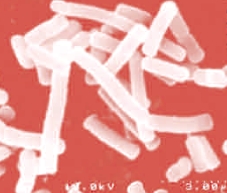As part of a natural ecosystem, many organisms develop symbiotic relationships with other living things. In humans, for example, the gastrointestinal tract provides an optimal environment for bacterial growth. These bacteria assist with the host’s food digestion, protect from mechanical and chemical injury, and maintain a healthy immune system.
Today, a Westernized diet provides a less favorable environment for health-promoting bacteria to grow. A stressful lifestyle, frequent use of medicine and aging may also shift the balance between beneficial and harmful bacteria. When the balanced commensal microbiota are disturbed, it may result in abnormal gastrointestinal motility, digestion and absorption, as well as infections and inflammation. This may explain the increasing incidence of gastrointestinal problems in industrialized nations.
Multiple clinical studies have recently shown the efficacy of probiotics in the restoration of gastrointestinal health. In particular, a strain of Lactobacillus, Lactobacillus plantarum 299v (Lp 299v), has been shown to have an exceptional ability to provide digestive and protective support with strong adhesion and growth within the gut. These organisms seem to reverse some of the pathology and associated symptoms in even severe conditions, such as irritable bowel syndrome (IBS).
What is Lactobaccilus plantarum 299v?
|
|
| Lactobaccilus plantarum 299v (Lp 299v). |
The genus Lactobacillus contains more than 125 species, and is commonly found in yogurt, cider, wine, sauerkraut, pickles, cheese, chocolate and other fermented foods (1). Of these species, Lactobaccilus plantarum 299v (Lp 299v) in particular (see Figure 1) was first isolated from human intestine, and has been shown to have exceptional abilities including:
• mucosal binding and colonization
• tolerance to a variety of stresses (e.g., pH, bile acid)
• prevention of inflammatory changes in disease models (e.g.,modulated secretion of pro-inflammatory cytokines and other associated factors)
• regulation of bacterial overgrowth
• enhancement of vaccine efficacy when supplemented immediately after the vaccine treatment (2–5)
These characteristics make the Lp 299v strain a superior probiotic strain compared to other commensal bacterial strains. The complete Lp 299v genome has been mapped, and it is one of the best understood L. plantarum strains on the market in terms of benefits and safety (1).
Mechanisms of Action
Reduced growth and penetration of pathogens. Lp 299v has been shown to have exceptional adherence and colonization characteristics on gut mucosa, compared to other previously tested strains, even in the presence of commonly used antibiotics (6,7). This ability prevents the adhesion and translocation (i.e., penetration and entrance through the gut’s protecting layers) of pathogens (7, 8). Lp 299v is known to stimulate mucin secretion, which hinders the growth of disease-promoting bacteria (9, 10). Stable colonization of Lp 299v may also slow down pathogen expansion by competing for nutrients and secreting antitoxins, such as hydrogen peroxide and benzoic acid, which are toxic to many pathogenic bacteria (11–14). Furthermore, the production of short-chain fatty acids (SCFAs) by Lp 299v lowers colon luminal pH, creating an unfavorable environment for the growth of pathogens including molds, yeasts and bacteria (13, 15). This general inhibition of pathogen growth leads to a reduction in circulating endotoxins, which would otherwise cause overstimulation of the immune system and associated infections and inflammation (16). In addition, multiple studies have shown that Lp 299v reduces the colonization of Enteropathogenic E.coli (EPEC), a gram-negative bacteria that is often associated with occasional diarrhea and bowel discomfort (17, 18).
 |
| Figure 2: Lp 299v mechanism of action. Lp 299v supports gastrointestinal, immune, and cognitive health through: 1) persistent adhesion and growth, 2) secretion of protective mucin, 3) early development of a healthy immune system and maintenance of a balanced immune response against harmful versus non-harmful agents, 4) enhancement of food digestion and metabolism, 5) secretion of anti-pathogenic molecules, and 6) modulation of cytokines, chemokines, and other factors that play important roles in immunity and cognitive functions, and 7) facilitation of appropriate and efficient cell–cell and cell–particle communications, which are critical for normal body function. |
Healthy digestion and nutritional support. Lp 299v, among many other gut flora, plays an essential role in general digestion and nutritional absorption. It metabolizes sugars and fibers into vital nutrients such as SCFAs, polyamines, vitamins, antioxidants and amino acids. They are the primary nutrients for colonocytes and are essential for general gastrointestinal health and function (13, 19).
Immune health. Lp 299v not only benefits the general health of the gastrointestinal tract, but also the immune system. Healthy colonization of Lp 299v alters cytokine (IL-10, INFg, TNFa), immune cells (T-cells, macrophages, and antibody producing cells) and metabolic profiles in the intestine, which positively affects immune function. Some studies have indicated that the positive effects on immune function may also promote enhanced memory and learning behavior (29, 10, 20, 21). In addition, the presence of beneficial bacteria can stimulate the expression of certain proteins and factors on cell membranes that change the cell–cell and cell–particle interactions in the gut and surrounding tissues (22).
Effect of Lp 299v Clinical Data
Chronic digestive condition: irritable bowel syndrome (IBS). IBS is a common disease that currently affects 10–20% of the adult population in developed countries, and the number of affected individuals is expected to reach over 100 million by 2012. Symptoms often include abdominal pain, flatulence, bloating, diarrhea and constipation (23). These symptoms will interfere with daily activities and affect a patient’s quality of life. However, currently available medications and other therapies have only limited efficacy and fail to relieve IBS symptoms over the long term (24).
The composition of microflora significantly contributes to gastrointestinal health, and an increasing number of studies have reported an association between the alternation of microbiota and IBS development. Lp 299v has been widely used in many pre-clinical and clinical IBS studies due to its exceptional ability to adhere, grow and balance immune responses in hosts. Many of the published studies have shown promising improvements in IBS symptoms, compared to other treatments and placebo groups. The improvements include, but are not limited to, the following:
• Reduction of flatulence and bloating,
• Reduction of abdominal pain,
• Normalization of frequency and volume of stools,
• Improvement of general gastrointestinal health.
Autoimmune disease: inflammatory bowel disease (IBD). IBD is a group of inflammatory diseases in the gastrointestinal tract. The most common forms of IBD are Crohn’s disease and ulcerative colitis (25–27). Common symptoms include, but are not limited to, abdominal pain, vomiting, diarrhea, hemotochezia (bloody stools) and weight loss. Again, as with IBS, these symptoms significantly impact quality of life. Currently available therapies have limited efficacy and often involve extended exposure to steroidal medicines and/or invasive surgeries (28). Although the causes of IBD have not been elucidated, it is hypothesized that an over-reactive host immune system may be attacking various parts of the body’s own gastrointestinal tract in the absence of invading pathogens (37).
An increasing number of studies have shown that probiotics, particularly Lp 299v, have significant benefits in IBD, with no known complications or side effects (29).
For example, Lp 299v treatment studies using animal colitis disease models have reported induced secretion of the anti-inflammatory cytokine, IL-10 (20). In the same studies, Lp 299v also reduced the secretion of mucosal IL-12 and IFN-g, which are pro-inflammatory and immunostimulatory cytokines that are associated with the development of autoimmune diseases such as IBD (30–37). Furthermore, the treatment significantly inhibited the transport and translocation of harmful endotoxins and bacterial pathogens across the mucosal layers in these IBD models (38). Thus, Lp 299v may be an alternat ive therapy for IBD and related symptoms. WF

Kaori Dadgostar, Ph.D, is a technical specialist for Jarrow Formulas. She obtained her Ph.D. from the Molecular Biology Institute at UCLA. Dadgostar has extensive experience in project and laboratory management and technical development in both academia and pharmaceutical companies. Her multi-disciplinary collaborations as well as her work in protein/peptide/ small molecule chemistry, antibody engineering, and imaging have led to numerous published papers, grants and patents.
References
1. M. Kleerebezem et al., “Complete Genome Sequence of Lactobacillus plantarum WCFS1,” Proc. Nat. Acad. Sci. 100 (4), 1990-1995 (2003).
2. J. Maukonen et al., “Intra-Individual Diversity and Similarity of Salivary and Faecal Microbiota,” J. Med. Microbiol. 57, 1560–1568 (2008).
3. Jacobsen CN, et al., “Screening of Probiotic Activities of Forty-Seven Strains of Lactobacillus spp. by in vitro Techniques and Evaluation of the Colonization Ability of Five Selected Strains in Hmans,” Appl. Environ. Microbiol. 1999; 65(11): 4949–4956.
4. J.A, Vanderhoof, “Probiotics: Future Directions,” Am. J. Clin. Nutr. 73, 1152S–1155S (2001).
5. I. Adlerberth et al., “A Mannose-Specific Adherence Mechanism in Lactobacillus plantarum Conferring to the Human Colonic Cell Line HT-29,” Appl. Environ. Microbiol. 62, 2244–2251 (1962).
6. M.L. Johansson et al., “Survival of Lactobacillus plantarum DSM 9843 (299v), and Effect on the Short-Chain Fatty Acid Content of Faeces after Ingestion of a Rose- Hip Drink with Fermented Oats,” Int. J. Food Microbiol. 42 (1–2), 29–39 (1998).
7. B. Klarin et al., “Adhesion of the Probiotic Bacterium Lactobacillus plantarum 299v onto the Gut Mucosa in Critically Ill Patients: A Randomized Open Trial,” Crit. Care 9 (3), R285–293 (2005).
8. P. Mangell et al., “Lactobacillus plantarum 299v Inhibits Escherichia coli-Induced Intestinal Permeability,” Dig. Dis. Sci. 47 (3), 511–516 (2002).
9. D.R. Mack et al. , “Probiotics Inhibit Enteropathogenic E. Coli Adherence in vitro by Inducing Intestinal Mucin Gene Expression,” Am. J. Physiol. 276, G941–G950 (1999).
11. J. Levy, “The Effects of Antibiotic Use on Gastrointestinal Function,” Am. J. Gastroenterol. 95, S8–S10 (2000).
12. M. Percival, “Choosing A Probiotic Supplement,” Clin. Nutr. Insights 6, 1–4 (1997).
13. Y. Aiba et al., “Lactic Acid-Mediated Suppression of Helicobacter pylori by the Oral Administration of Lactobacillus salivarius as a Probiotic in a Gnotobiotic Murine Model,” Am. J. Gastroenterol. 93, 2097–2101 (1998).
14. P. Gionchetti et al., “Oral Bacteriotherapy as Maintenance Treatment in Patients with Chronic Pouchitis: A Double-Blind, Placebo-Controlled Trial,” Gastroenterol. 119, 305–309 (2000).
15. J.A. Drisko, C.K. Giles and B.J. Bischoff, “Probiotics in Health Maintenance and Disease Prevention,” Altern. Med. Rev. 8 (2), 143–155 (2003).
16. S. Michail and F. Abernathy, “Lactobacillus plantarum Reduces the in vitro Secretory Response of Intestinal Epithelial Cells to Enteropathogenic Escherichia coli Infection,” J. Pediatr. Gastroenterol. Nutr. 35 (3), 350–355 (2002).
17. S.D. Todorov et al., “Optimization of Bacteriocin Production by Lactobacillus plantarum ST13BR, A Strain Isolated from Barley Beer,” Gen. Appl. Microbiol. 50 (3), 149–157 (2004).
18. H. Majamaa and E. Isolauri “Probiotics: A novel Approach in the Management of Food Allergy,” J. Allergy Clin. Immunol. 99, 179–185 (1997).
19. S. Pathmakanthan et al., “Lactobacillus plantarum 299: Beneficial in vitro Immunomodulation in Cells Extracted from Iflamed Human Colon,” J. Gastroenterol. Hepatol. 19 (2), 166–173 (2004).
20. M.W. Herías et al., “Immunomodulatory Effects of Lactobacillus plantarum Colonizing the Intestine of Gnotobiotic Rats,” Clin. Exp. Immunol. 116 (2), 283–290 (1999).
21. C.L. Sears, “A Dynamic Partnership: Celebrating our Gut Flora,” Anaerobe 11 (5), 247–251 (2005).
22. B. Coffin et al., “Relationship Between Severity of Symptoms and Quality of Life in 858 Patients with Irritable Bowel Syndrome,” Gastroenterol. Clin. Biol. 28 (1), 11–15 (2004).
23. D.M. Brenner et al., “The Utility of Probiotics in the Treatment of Irritable Bowel Syndrome: A Systematic Review,” Am. J. Gastroenterol. 104, 1033–1049 (2009).
24. D.C. Baumgart and S.R. Carding, “Inflammatory Bowel Disease: Cause and Immunobiology,” The Lancet 369 (9573), 1627–1640 (2007).
25.D.C. Baumgart and W.J. Sandborn, “Inflammatory Bowel Disease: Clinical Aspects and Established and Evolving Therapies,” The Lancet 369 (9573): 1641–1657 (2007).
26. R.J. Xavier and D.K. Podolsky, “Unravelling the Pathogenesis of Inflammatory Bowel Disease,” Nature 448 (7152), 427–434 (2007).
27. Gaia Garden, A Phytotherapeutic Approach to Lower Bowel Disease.
28. W. Kruis et al., ”Maintaining Remission of Ulcerative Colitis with the Probiotic Escherichia coli Nissle 1917 Is as Effective as with Standard Mesalazine.” Gut 53 (11), 1617–1623 (2004).
29. M. Schultz et al., “Lactobacillus plantarum 299v in the Treatment and the Prevention of Spontaneous Colitis in Interleukin-10-Deficient mice,” Inflammatory Bowel Diseases, March 2002, 8(2):p.71-80 (2002).
30. S. Fais et al., “Interferon Expression in Crohn’s Disease Patients: Increased Interferon- and - mRNA in the Intestinal Lamina Propria Mononuclear Cells,” J. Interferon Res. 14, 235–238 (1994).
31. I.J. Fuss et al., “Disparate CD4+ Lamina Propria (LP) Lymphokine Secretion Profiles in Inflammatory Bowel Disease: Crohn’s Disease LP Cells Manifest Increased Secretion of IFN-, Whereas Ulcerative Colitis LP Cells Manifest Increased Secretion of IL-5,” J. Immunol. 157, 1261–1270 (1996).
32. G. Monteleone et al., “Interleukin 12 Is Expressed and Actively Released by Crohn’s Disease Intestinal Lamina Propria Mononuclear Cells,” Gastroenterol. 112, 1169–1178 (1997).
33. P. Parronchi et al., “Type 1 THelper Cell Predominance and Interleukin- 12 Expression in the Gut of Patients with Crohn’s Disease,” Am. J. Pathol. 150, 823-832 (1997).
34. S.E. Plevy et al., “A Role for TNFAlpha and Mucosal T Helper-1 Cytokines in the Pathogenesis of Crohn’s Disease,” J. Immunol. 159, 6276–6282 (1997).
35. A.W.G. Waugh et al., “Effect of Lactobacillus plantarum 299v Treatment in an Animal Model of Irritable Bowel Syndrome,” Micr. Ecol. Health Dis. 21 (1), 33–37 (2009).
36. P.J. Mannon et al., “Anti-Interleukin-12 Antibody for Active Crohn’s Disease,” New Engl. J. Med. 351 (20), 2069–2079 (2004).
37. G. Mangiante et al., “Lactobacillus plantarum Reduces Infection of Pancreatic Necrosis in Exper imental Acute Pancreatitis, ” Dig. Surg. 18, 47–50 (2001).
Published in WholeFoods Magazine, October 2010










